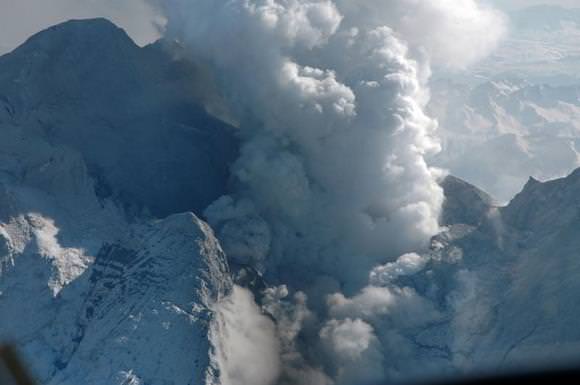[/caption]
Feel the ground. It’s nice and cool, right? Well, dig down a few kilometers and things really heat up. Once you’re down more than 30 km, and temperatures can reach more than 1,000 degrees C; that’s hot enough to melt rock. The melted rock is called magma, and it collects into vast chambers beneath the Earth’s surface. The molten rock is less dense than the surrounding rock and so it “floats” upwards through cracks and faults. When the magma finds its way to the surface, it erupts as lava, rock, ash and volcanic gases; this is a volcanic mountain.
A volcanic mountain starts out as a simple crack in the Earth called a volcanic vent. Magma erupts out of the ground as lava flows, clouds of ash, and explosions of rock. This material falls back to Earth around the vent, and piles up around it. Over time (and sometimes quite quickly) a volcanic mountain builds up, with the familiar cone shape.
There are different kinds of volcanic mountains. Cinder cone mountains are made up of material blasted out that rains back down. They don’t usually grow too large. Shield volcanoes are built up by many lava flows of low viscosity lava (low viscosity means that it flows more easily). The lava can flow for dozens of kilometers, and the volcano can be very wide. A stratovolcano or composite volcano is made up of many layers of ash, rock and hardened lava. Some of the largest, most impressive volcanoes in the world are stratovolcanoes (think about Mount Fuji or Rainier).
And we don’t just have volcanic mountains here on Earth. The largest mountain in the Solar System is Olympus Mons on Mars. This enormous shield volcano has grown to more than 21 km tall. There are also active volcanoes on Jupiter’s moon Io.
We have written many articles about volcanoes for Universe Today. Here’s an article about the biggest volcano in the Solar System, and here’s an article about different types of volcanoes.
Want more resources on the Earth? Here’s a link to NASA’s Human Spaceflight page, and here’s NASA’s Visible Earth.
We have also recorded an episode of Astronomy Cast about Earth, as part of our tour through the Solar System – Episode 51: Earth.

